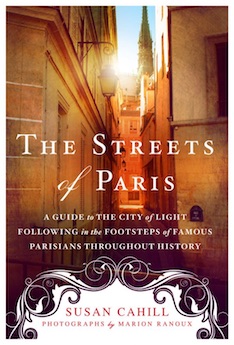By Indira Ganesan
“Beauty is in the streets, they say in Paris,” Susan Cahill (ΦBK, Fordham University, 1995) writes in her introduction to this travelogue of the city, further saying that the streets themselves “are the stories.” They hold the memories and secrets of those who lived as artists and writers, thinkers, and politicians who walked along the Seine, crossed the streets to drink coffee and meet friends, and held secret rendezvous. Cahill recounts the stories of twenty-two Parisians who are icons of France: Piaf, Montaigne, Heloise and Abelard, Chopin, Giacometti, and Camus among others. We get glimpses of their lives, the addresses where they lived, and how to go about visiting these places. Along the way to Ile Saint-Louis to see the street where Honore Daumier had his attic studio, Cahill points out where to stop for ice cream (Berthillon, 29-31 rue des Duex Ponts, after taking in the view from Place Louis Aragon).
Her directions are precise and far more interesting than google maps. We are told when and how to turn, and what to see along the way. It is as if a dear friend has taken your arm and happily guides you around a city they love.
“As you start your search for Giacometti’s studio,” she advises, “everything depends on slowing down, taking it easy, opening yourself up to the modesty of this old rural quartier once alive with goats and mules and horses.” You are in Montparnasse, having exited the Metro, on your way to no. 46, rue Hippolyte-Maindron, to see where the sculptor worked.
We hear about the sixteen Carmelite nuns, hair freshly shorn, singing their way to the guillotine in two wooden carts as a silenced crowd watched in 1794. We are told the story of how Marguerite de Valois, married at eighteen to Henri IV, saved her husband’s life as she hid him in the Louvre while her mother, Catherine de Medici, orchestrated the slaughter of some ten thousand Protestants. We learn that Simone Weil’s family once lived in what is now a Benneton. The book is full of asides and quips, and practicalities as to which Metro to take, which bridge to cross.
Following each chapter on the luminaries, which are accompanied by moody photographs by Marion Ranoux, are worthwhile tidbits under a category called “Nearby.” Each of the Nearbys tells you how to wander to and from the place you are visiting. For instance, Cahill tells us the proprietor of “La Prarie Boulangerie at 50 bis, rue de Douai as you face Square Berlioz (Metro: Blanche; Place de Clichy)” serves not only “excellent pastry” but will provide “clear directions to Zola’s last home in Paris.”
The book is hefty, printed on glossy paper, weighing in at over a pound in trade paperback, so maybe best to be checked, not carry-on, yet how delicious would it be to sit in a window seat, wrapped up in a home-brought blanket, and peruse at high altitude? There are no maps, because an investigator of the city, the flaneur-detective, needs only landmarks. Strolling, stopping for that excellent pastry, one stumbles upon so many lives lived. Maybe the heft of the book grounds us, as it is easy to fall head-first into a romance with the city of light.
At the end of the book, we are told that forty thousand mourners followed Edith Piaf’s coffin, “closing the streets for the first time since the Liberation.” She was denied a church burial by the Vatican that declared she lived in a state of sin, never mind she was a resistor who helped free at least 118 prisoners of war by supplying them with maps, compasses, and false I.D.s. This is Paris, a city of beauty and contradiction, full of ghosts and nostalgia, pressing forward, always.
Novelist Indira Ganesan was inducted into Phi Beta Kappa at Vassar College in 1982. Her books include The Journey (Alfred A. Knopf, 1990), Inheritance (Alfred A. Knopf, 1998) and As Sweet As Honey (Alfred A. Knopf, 2013).




